
Porto, Portugal

Contents: 13.1- Traps Associated with Autochthonous Salt 13.2- Traps Associated with Allochthonous Salt 13.3- Traps Above and Backward of Salt Nappes 13.4- Traps Above Salt Nappes 13.5- Traps Below salt Nappes 13.6- Gulf Coast Examples
The geological cross-sections of offshore Angola (fig. 283, 106, etc.) and Gulf of Mexico (fig. 105, 307, 308, etc.) clearly indicate the potential traps associated with autochthonous and allochthonous salt layers are quite different. In the offshore Angola, the old Seffel lines (1968) illustrated on fig. 319, and particularly the upper one, show huge structural traps (four way dip closure). Taking into account their horizontal scale, it is predictable that at smaller scale, a large number of normal-faults affect the apexes of the structures. They are extensional and not compressional features.
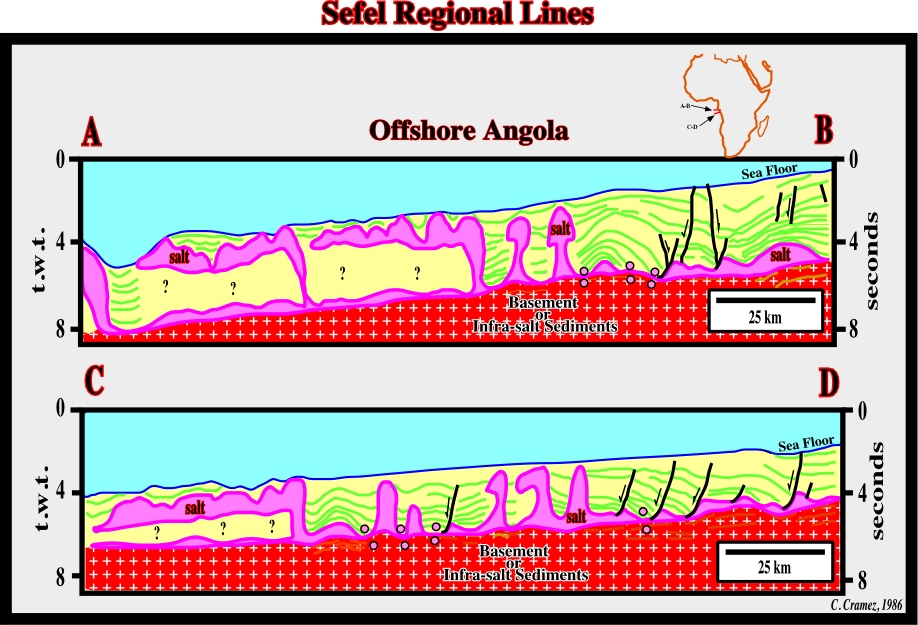
Similarly, on the cross-sections of the Gulf of Mexico, the principal traps associated with the autochthonous salt are morphological by juxtaposition. All them were directly, or indirectly, created by combination of halokinesis and extensional tectonic regime. In other words, one can say that in such a traps there are always normal-faults associated with the closed surface. Therefore, due to the fault displacement, a seal rock can be put in juxtaposition with potential reservoirs. In association with the allochthonous salt, and independently of the different geological settings associated with (fig. 320), morphological traps are also frequent, particularly in deep-water settings, in which turbiditic deposits are paramount. Stratigraphic and structural traps are sometimes present. Admittedly, in the fold belts, structural traps are preponderant.
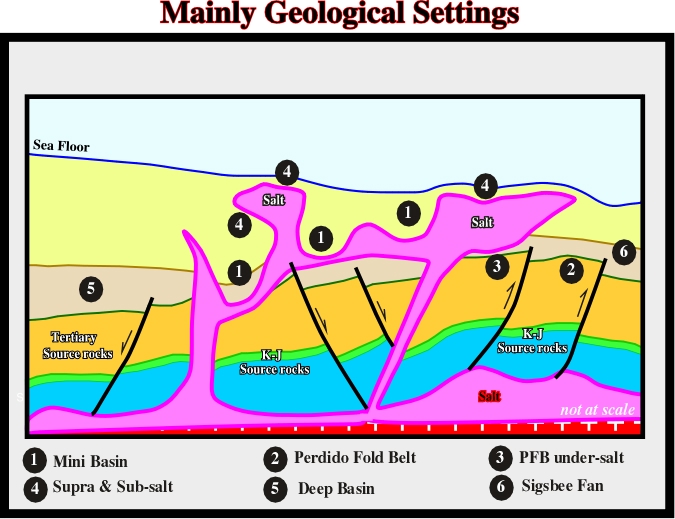
Shortly,
- With autochthonous salt, the more frequent traps are:
(i) Morphological by juxtaposition induced by normal faulting;
(ii) Stratigraphic (pinchout, facies changes, etc.).
- With allochthonous salt, the more frequent traps are:
(i) Morphological by juxtaposition against allochthonous salt;
(ii) Morphological (turdidite depositional systems);
(iii) Stratigraphic (pinchouts);
(iv) Structural (fold belts).
13.1- Traps Associated with Autochthonous Salt
This family of traps was consistently tested in Angola and Gulf Coast. It can be illustrated by two typical cross-sections (fig. 321 and 322).
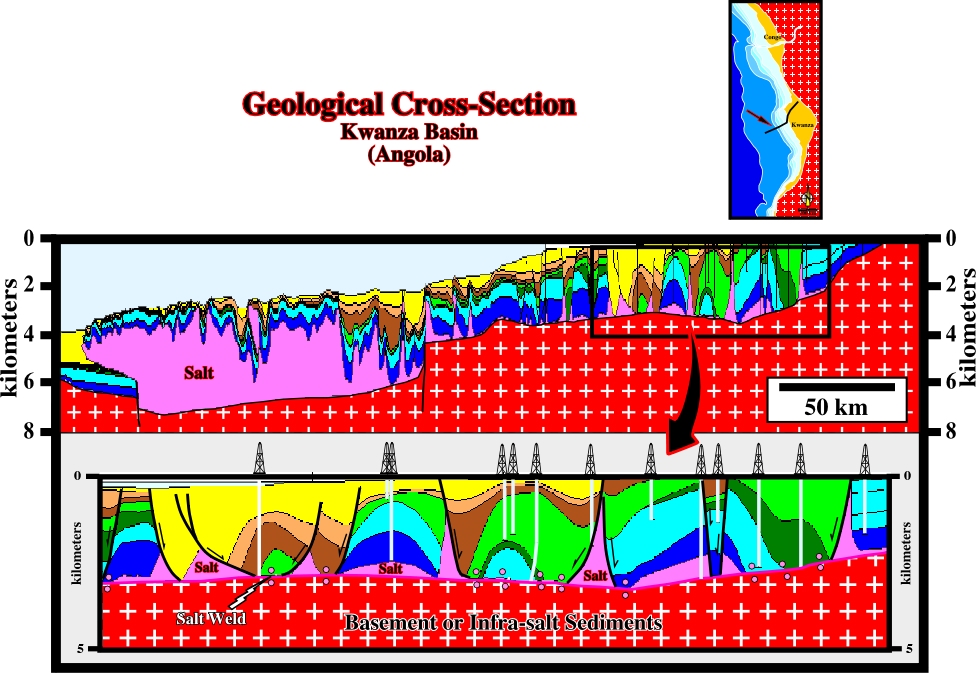
In the offshore, the majority of the wells drilled until the discovery of Girassol (block 17) tested large antiforms associated with Cretaceous and Tertiary depocenters between rafts, and stratigraphic traps within the Pinda formation (Albian limestones). After the calibration and the understanding of the Girassol #1, explorationists started a hydrocarbon exploration based mainly in seismic amplitudes, assuming that an amplitude anomaly underlies often a hydrocarbon accumulation. After several exploratory wells, most of the explorationists became skeptical:
- The recoverable reserves do not seem so big as predicted.
- The profitability still is questionable, since the majority of the reservoirs are related to slope fan turbidite depositional systems.
Indeed, in deep water, an accumulation, in stand alone, must satisfy two major conditions:
(i) The recoverable reserves must be near 400 Mb.
(ii) The productivity per well should not lower than 10 kb/d.
The profitability is completely different from the GOM, where accumulation of 50-100 Mb recoverable can readily be developed. The cross-section from the East Texas, illustrated below (fig. 322), indicates the majority of the traps associated with the autochthonous salt are by juxtaposition induced by the relative displacement of the faulted blocks of the normal-faults.
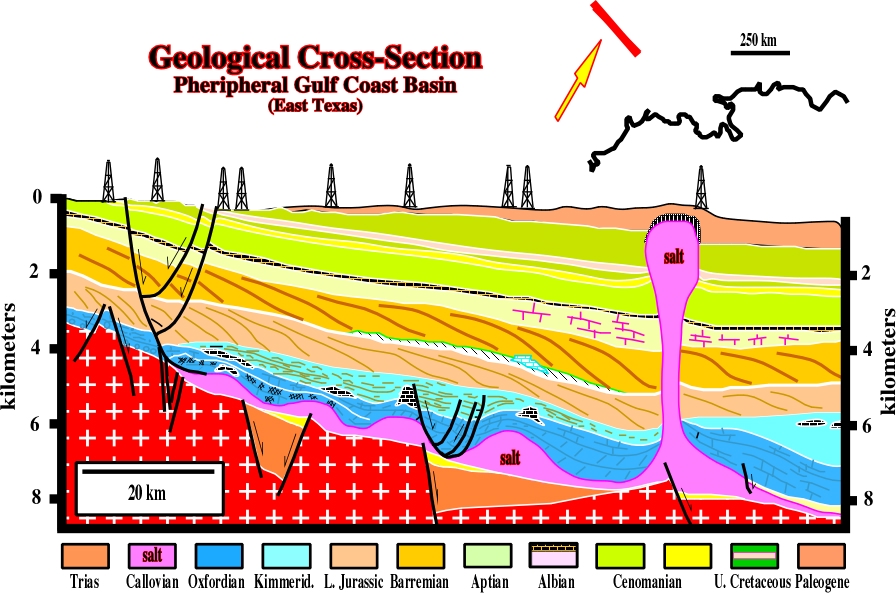
To sum up, one can say that in association with autochthonous salt, at least, in the Atlantic margins and Gulf Coast, the majority of the traps (fig. 323) are related with: -(i) Depocenters / Rafts; -(ii) Growth faults / Rollovers; -(iii) Salt Ridges; - (iv) Salt domes; - (v) Overhangs; - (vi) Turtle backs, etc.
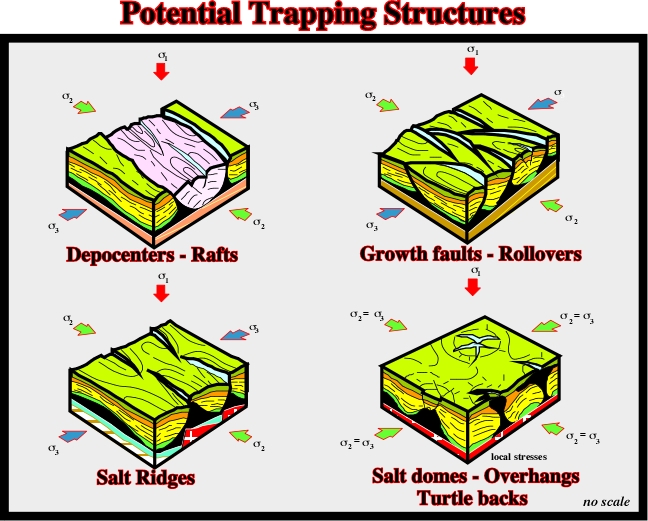
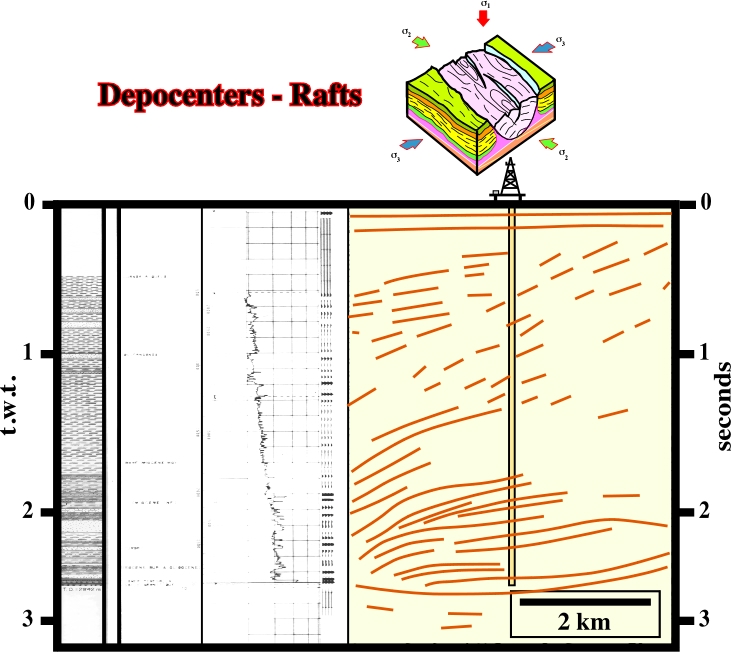
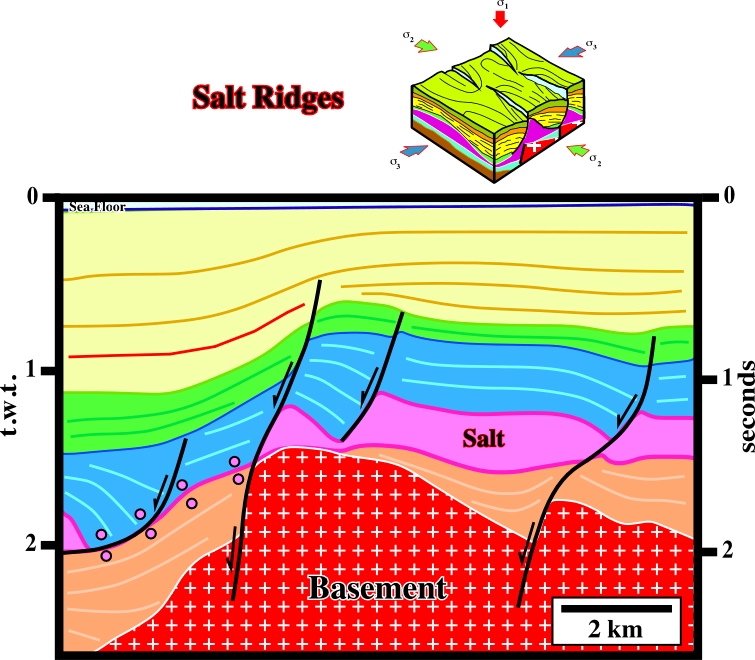
Fig. 328- Morphological traps by juxtaposition associated with the normal faults bounding salt ridges are quite frequents in offshore Angola, as illustrated on this seismic line.
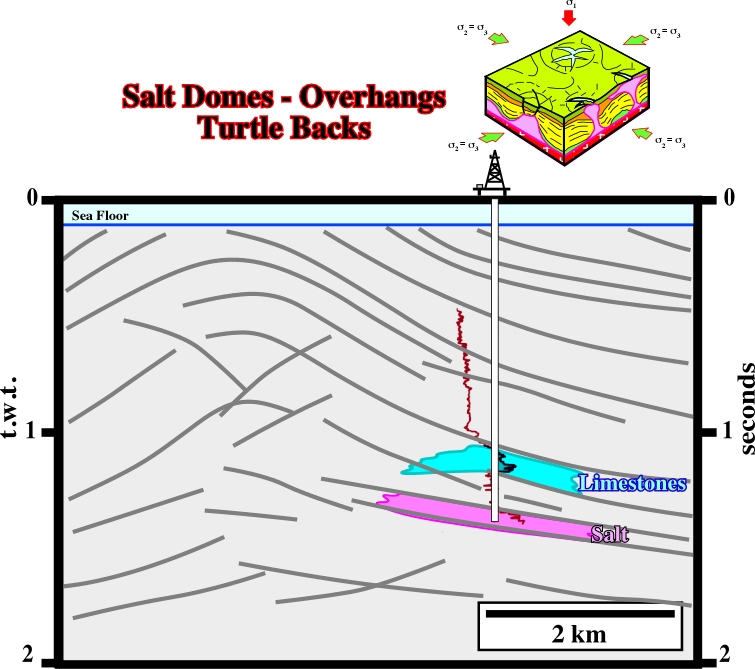
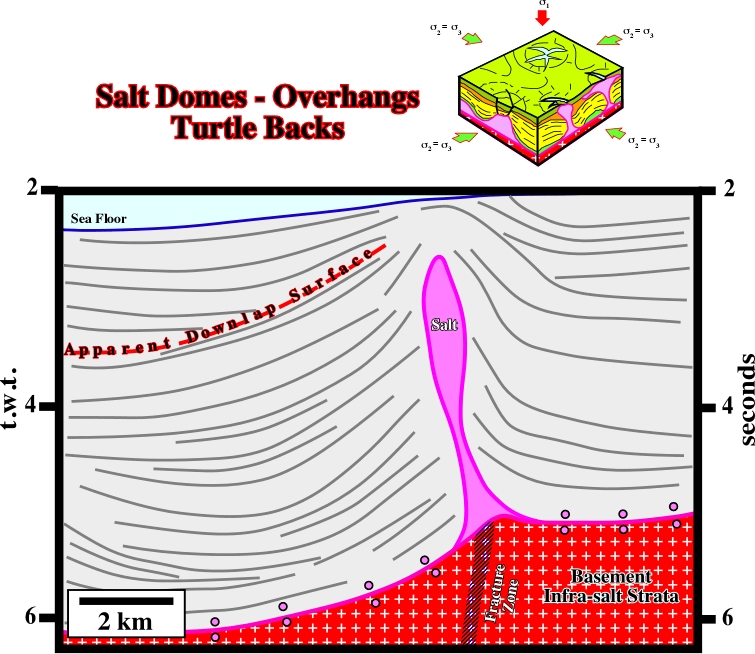
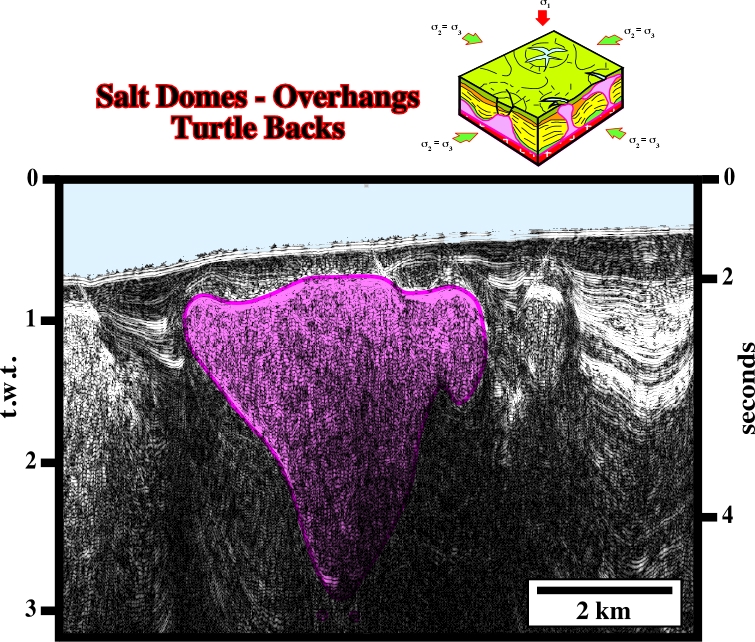

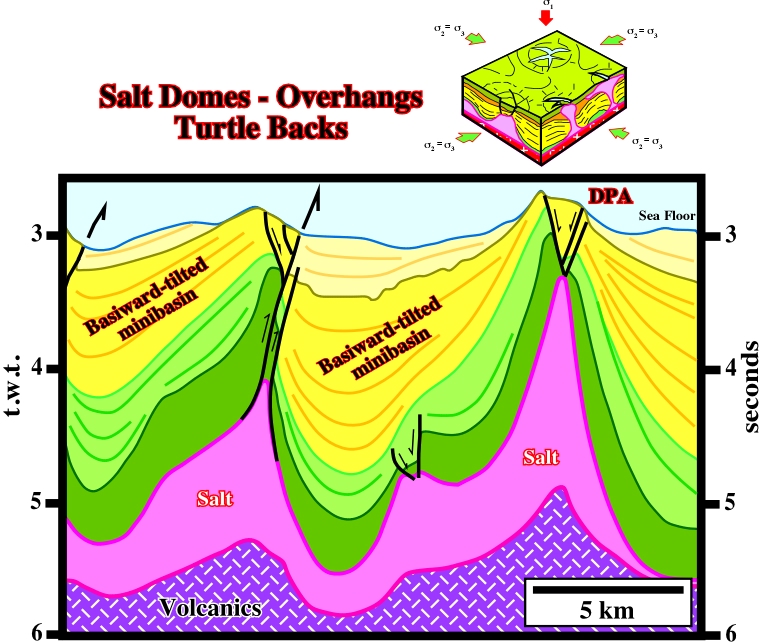
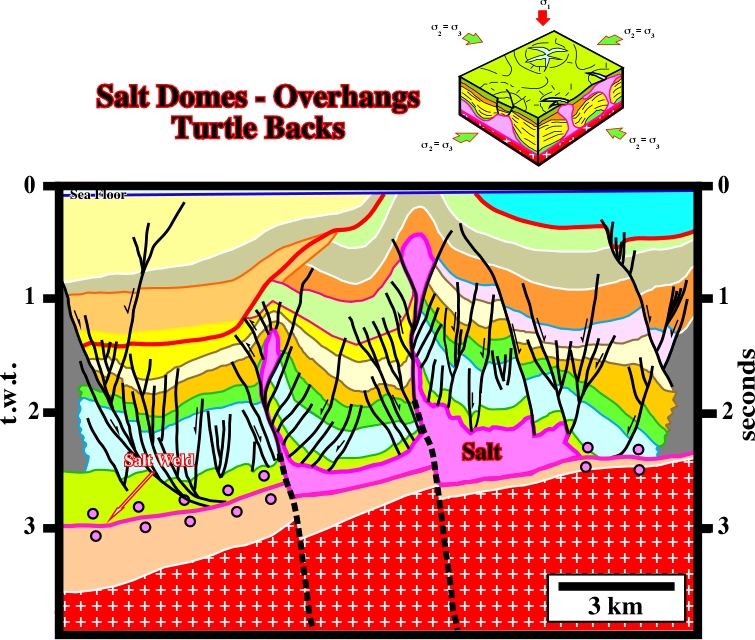
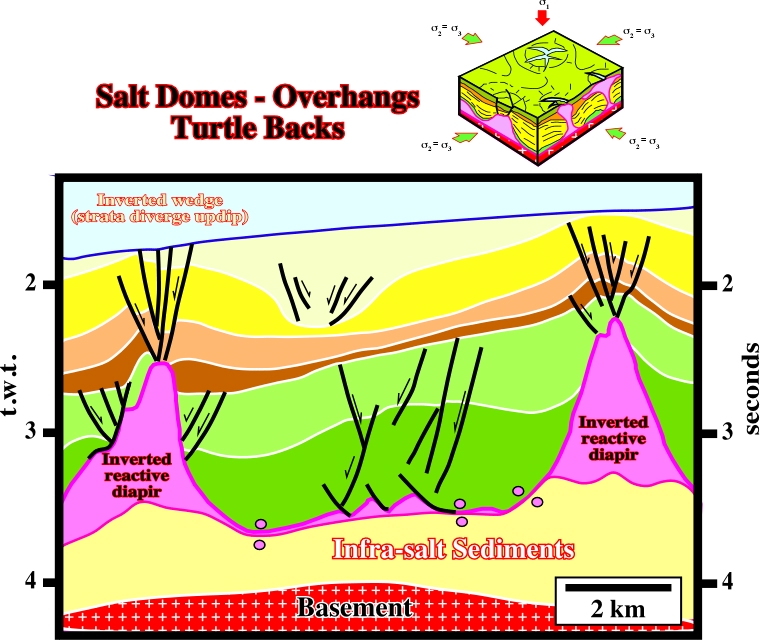
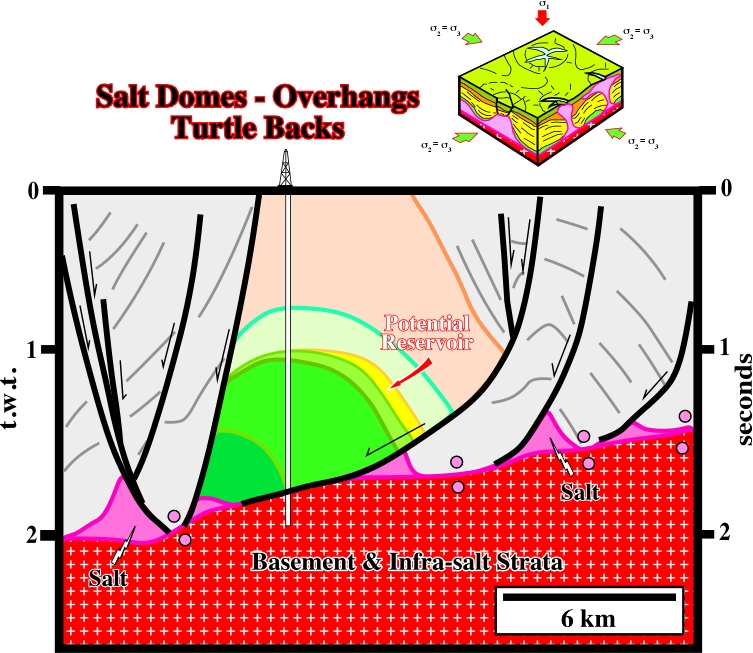
Fig. 336- The so called false turtle-backs that in fact correspond to back-raft structures have been tested in onshore Angola since the end 60’s. Some of these structures show a to four way dip closure. This kind of trap is quite frequent in deep offshore Brazil as illustrated in next figures.
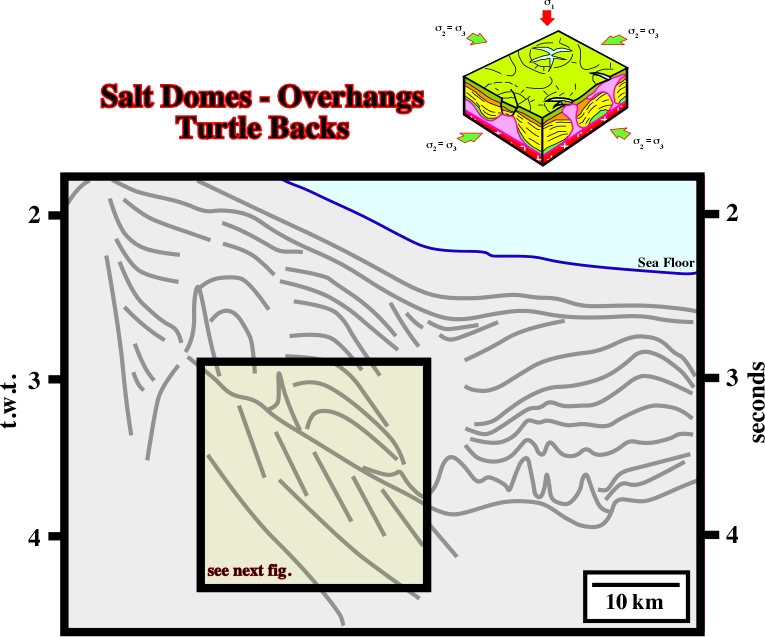
Fig. 337- This seismic line, from deep offshore Campos, illustrates the importance of the apparent turtle-back structures. The geometry of such structures is better seen on the close-up illustrated below (fig. 338).

13.2- Traps Associated with Allochthonous Salt
The cross-sections of the deep offshore Angola and Gulf of Mexico (fig. 339 and 340) show the kind of trapping associated with allochthonous salt. On the cross section of offshore Angola (see fig. 106), one can say:
(i) In the proximal area of the cross-section, the substratum of the salt is composed of continental crust (rift-type basin or basement), while in the distal part it is probably composed of volcanic crust (SDRs or oceanic crust).
(ii) In the distal part, the salt is allochthonous and thickened by thrusting.
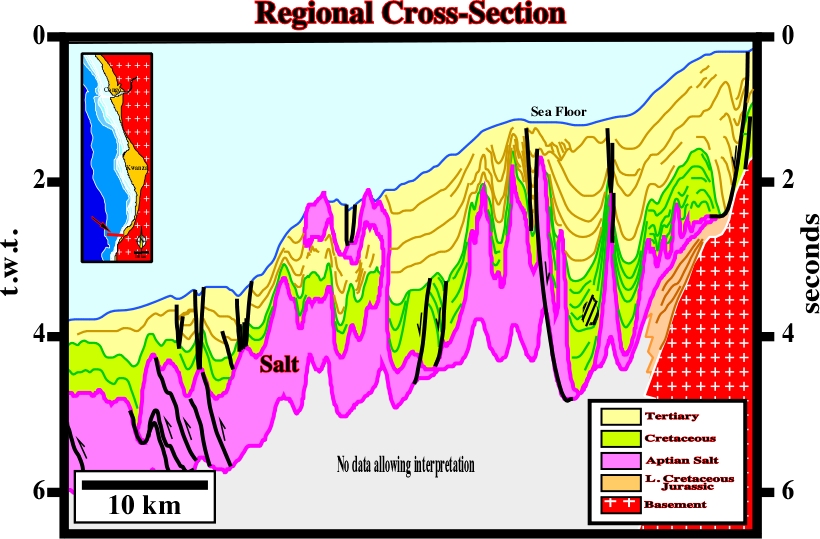
(iii) A fold belt is developed on the overlying sediments.
(iv) In the central part, the allochthonous salt is clearly separated from of the autochthonous salt.
(v) Within the allochthonous salt nappe, a small salt expulsion basin was developed.
(vi) Potential traps associated with the allochthonous salt are easily discernible from the geometry of the seismic reflectors of the overburden.
Similarly, on the time cross section of the Gulf Coast illustrated in fig. 340, the traps associated with the allochthonous salt are easy to distinguish using:
a) The geometry of the overburden reflectors.
b) The limits of the allochthonous salt.
c) The cartography of the fault planes.
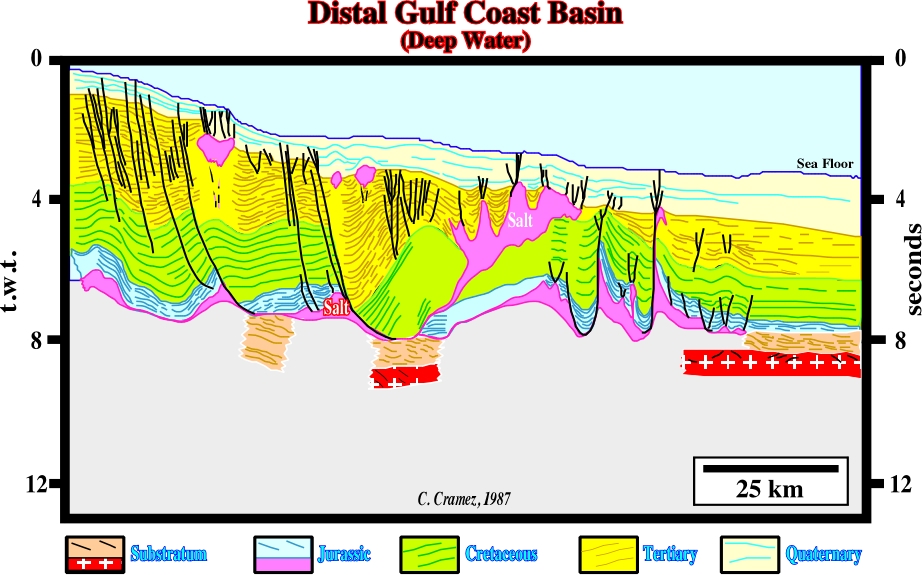
13.3- Traps Above and Backward of Salt Nappes
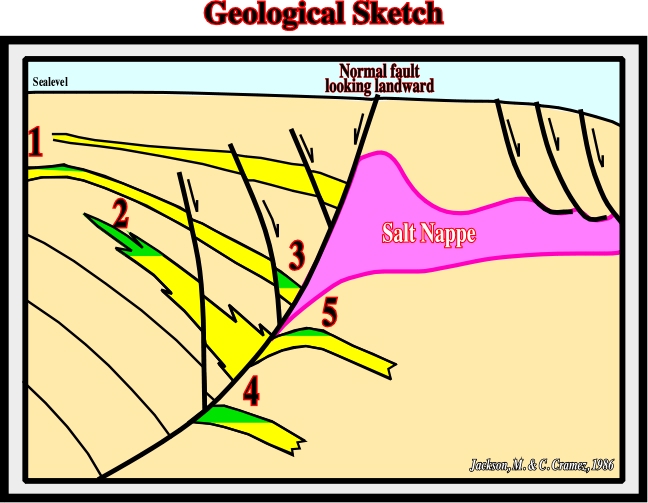
Fig. 341- On this geological setting the traps 1 and 5 are structural (they have a four way dip). The trap 2 is stratigraphic, while 3 and 4 are morphological by juxtaposition.
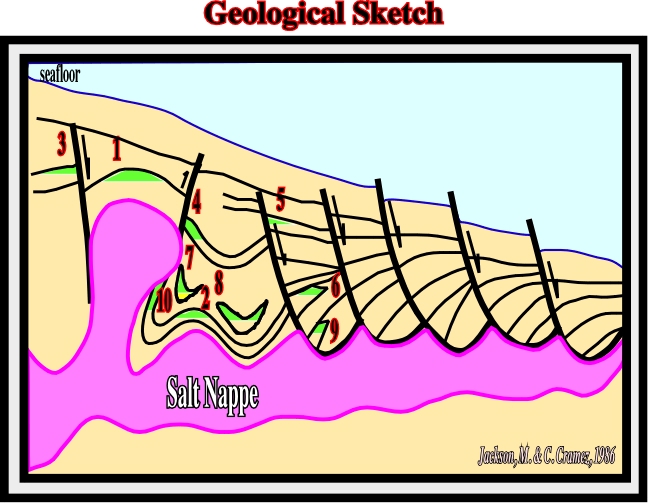
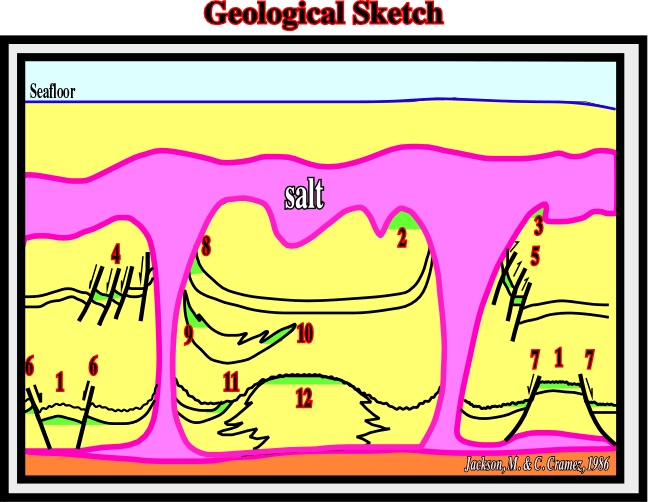
To finish this chapter, we will illustrate the principal effective traps found recently in the deep water province of the Gulf of Mexico, where one can consider five major geological provinces (fig. 344) with characteristic hydrocarbon parameters.
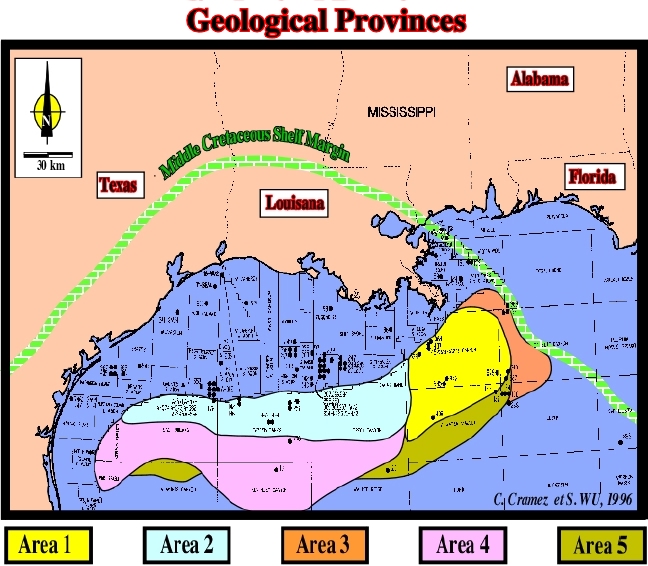
In area 1 (fig. 345), where the more characteristic effective traps are illustrated in fig. 345, the hydrocarbon parameters can be summarized as follows:
A) Reservoir, Good. Miocene to Pliocene turbidite depositional systems. Mainly associated with slope fans and debris flows.
B) Migration, Good.
C) Seal, Good (salt).
D) Maturation, Can be a problem. Migration is influenced by the distribution of allochthonous salt.
E) Trap, Good.
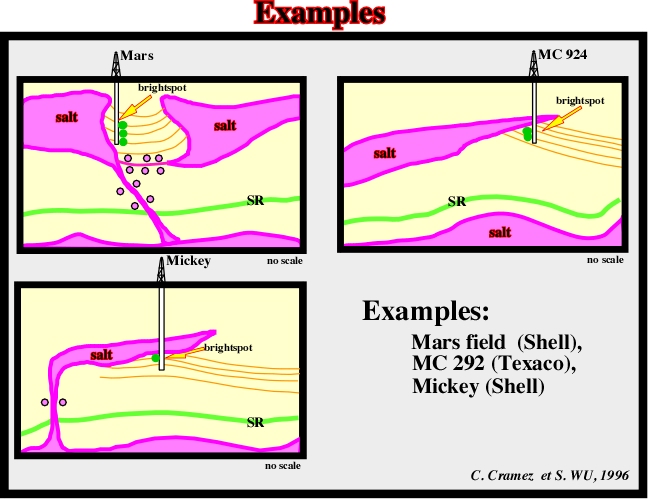
In area 2 (fig. 346), the hydrocarbon parameter can be summarized as:
A) Reservoir, Good. Plio-Pleistocene shingled turbidites, mainly within salt expulsion basins.
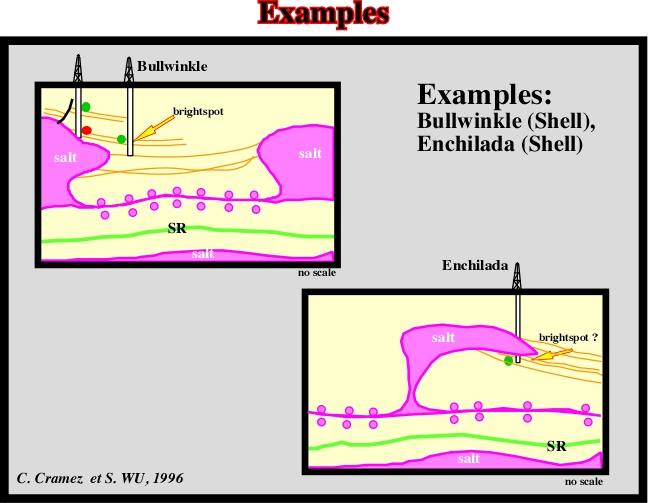
B) Migration,Good, through salt welds and fault planes.
C) Seal, Good. However, when the juxtaposition is not against salt, sealing problems can occur.
D) Maturation, Good.
E) Trap, Good, but difficult to map.
In area 3 (fig. 347), the hydrocarbon parameters can be summarized as follows:
A) Reservoir, Good. However, it is difficult to identify and map the reservoirs, but if they are underline by amplitude anomalies.
B) Migration, Good.
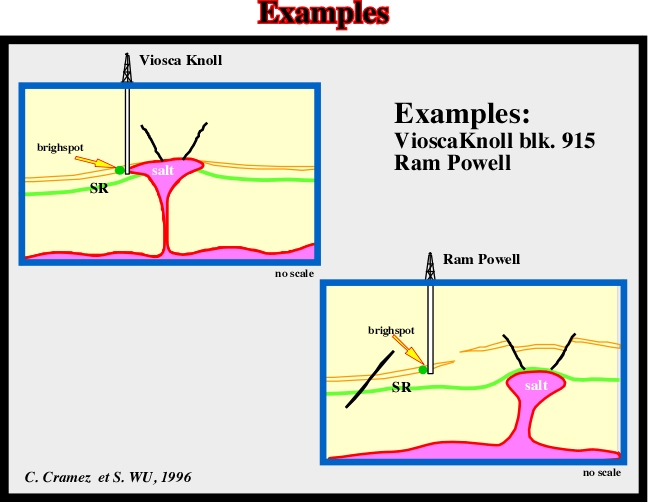
Fig. 347- Area 3. Stratigraphic Traps. Onlapping of Miocene turbidite against halokinetic structures.
C) Seal, Good.
D) Maturation, Good.
E) Trap, Difficult to map without amplitude anomalies associated.
In area 4 (fig. 348), the hydrocarbons parameters can be roughly evaluated as follows:
A) Reservoir, Plio-Pleistocene turbidites, mainly shingled turbidites and basin floor fans. The extension and geometry of the salt expulsion basin is necessary.
B) Migration, Generally bad. The presence of a salt weld is necessary.
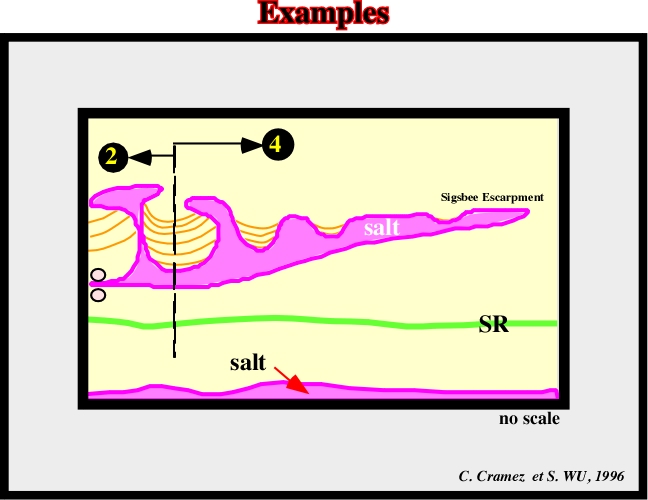
Fig. 348- Area 4. Traps by juxtaposition (against salt) associated with salt nappes of last generation with salt stocks or bottom of 2nd generation salt nappes.
C) Seal, Good.
D) Maturation, Generally good. However, it can be insufficient near the fold belts
E) Trap, Good, if potential reservoirs are well located.
In area 5 (fig. 349), the parameters are:
A) Reservoir, Good, mainly Middle Miocene turbidites.
B) Migration, Good.
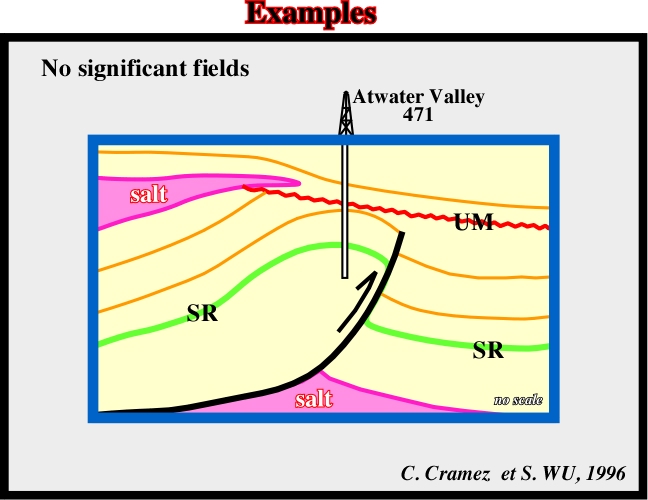
Fig. 349- Area 5. Structural traps in front or under 1st generation allochthonous salt nappe.
C) Seal, Good.
D) Maturation, Bad. So far, there is no evidence of source rocks.
E) Trap, Good.
to continue press
next
Send E-mails to ccramez@compuserve.com or cramez@ufp.pt with questions or comments about these notes.
Copyright © 2001 CCramez
Last modification:
Março 19, 2006